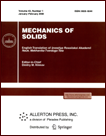 | | Mechanics of Solids
A Journal of Russian Academy of Sciences | | Founded
in January 1966
Issued 6 times a year
Print ISSN 0025-6544
Online ISSN 1934-7936 |
Archive of Issues
| Total articles in the database: | | 13362 |
| In Russian (Èçâ. ÐÀÍ. ÌÒÒ): | | 8178
|
| In English (Mech. Solids): | | 5184 |
|
| << Previous article | Volume 57, Issue 4 / 2022 | Next article >> |
| A.G. Temesgen, S.B. Singh, and T. Pankaj, "Modeling of Creep Deformation in an Internally Pressurized Transversely Isotropic Spherical Shell Subjected to a Thermal Gradient," Mech. Solids. 57 (4), 937-948 (2022) |
| Year |
2022 |
Volume |
57 |
Number |
4 |
Pages |
937-948 |
| DOI |
10.3103/S0025654422040185 |
| Title |
Modeling of Creep Deformation in an Internally Pressurized Transversely Isotropic Spherical Shell Subjected to a Thermal Gradient |
| Author(s) |
A.G. Temesgen (Department of Mathematics, Addis Ababa University, Addis Ababa, Ethiopia, tomye27@gmail.com)
S.B. Singh (Department of Mathematics, Punjabi University, Patiala, India, sbsingh69@yahoo.com)
T. Pankaj (Department of Mathematics, ICFAI University, Solan, India, pankaj_thakur15@yahoo.co.in) |
| Abstract |
Classical treatment for the analysis of creep stresses and strain rates uses the assumptions of material incompressibility, infinitesimally small creep deformation, creep strain laws, associated flow rule, and yield criterion that simplify the complexity of the problem in the theory of creep deformation. However, other materials cannot be treated with classical treatment such as compressibility effect in creep and transition stresses in creep. Seth developed the theory of creep transition which requires no assumptions, and this theory is important for evaluating creep transition stresses and for treating compressibility effect in creep based on Lebesgue strain measure. In this research paper, creep transition stresses and strain rates in a spherical shell of isotropic or transversely isotropic materials under a thermal gradient and uniform pressure are derived using the transition theory of Seth and the generalized strain measure theory. Results are obtained in non-dimensional quantities and are shown graphically and illustrated numerically. It is observed that the value of circumferential stress for spherical shell made of isotropic material is higher than the value of circumferential stress for spherical shell made of transversely isotropic material at a high temperature for both measures on the internal surface. The values of circumferential strain rate increase significantly as the measure increases for the spherical shell made of isotropic material at the internal surface. It is concluded that a spherical shell subjected to a higher radial temperature gradient and a pressure made of transversely isotropic material is on the safer side of the design compared to the cylinder made of isotropic material for lower measure. The findings of this paper can be used to analyze and design a spherical shell structure such as rapid centrifugal separators, gas turbines for high control flying machine motors, turning satellite structures, and other rotor systems. |
| Keywords |
creep transition, spherical shell, stress, temperature gradient, transversely isotropic |
| Received |
21 February 2022 | Revised |
23 April 2022 | Accepted |
23 April 2022 |
| Link to Fulltext |
|
| << Previous article | Volume 57, Issue 4 / 2022 | Next article >> |
|
 If you find a misprint on a webpage, please help us correct it promptly - just highlight and press Ctrl+Enter If you find a misprint on a webpage, please help us correct it promptly - just highlight and press Ctrl+Enter
|
|

 Russian
Russian  English
English